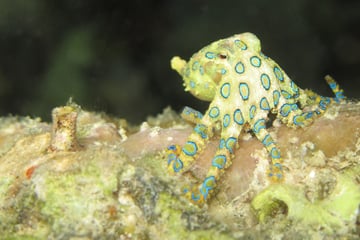What is the greediest animal in the world?
Tiny and seemingly unremarkable, the greediest animal in the world is a truly extraordinary creature that takes in an unbelievable amount of food in comparison to its body weight.

All of our favorite pets love to eat a good amount of food when it's provided to them.
Yet, it's not a cat, dog, turtle, Guinea pig, or snake that takes home the record for being the most "greedy" creature to walk this-here Earth.
The real winner, instead, is a creature so tiny that you'd think its greed insignificant.
So what is this strange-as-heck creature, and which little guy holds the animal world record for being greedier than all the rest?
This is the story of the greediest animal in the world and the reasoning behind the title.
What is the world's greediest animal?

The greediest animal in the world is the larva of the polyphemus moth (antheraea polyphemus). Guinness World Records has awarded this strange creature the title of world's greediest animal because of its extraordinary eating habits during the early stages of its life, as it develops towards becoming the moth it will one day be.
Within the first 56 days of its life, the larva of a polyphemus moth will eat around 86,000 times its own body weight. As Guinness World Records explains, this is the equivalent of "a 3.17 kilogram (7 pound) baby taking in 273 tons of nourishment" in just the first two months of its life.
The polyphemus moth is the most common silk moth type in the US, and also one of the most beautiful. Its name comes from the two spots on its back, which both look like eyes staring back at you, reminiscent of polyphemus, a giant cyclops from ancient Greek mythology.
Once the larva of the polyphemus moth have finished their remarkably greedy consumption habits, they will slowly grow into a caterpillar. Then, like in all the children's stories, they build a cocoon from which they emerge as an extraordinary moth.
What animals represent greed?
When thinking about greedy animals, there are two that come to mind: Toads and foxes. Of course, this is entirely symbolic and almost certainly not representative of reality - other insects are likely to consume more as-per their body weight than your average toad or fox.
The former represents greed because of a toad's habit of wanting to live both in water and on the land. As such, it is believed that the toad is wishing for more than it really deserves - especially considering the fact that toads, unlike frogs, can't swim yet in many cases still like to stay around water sources.
It would be bereft of us not to mention the fact as well that toads were represented as greedy in Kenneth Grahame's 1908 masterpiece The Wind in the Willows. In the book, the character Toad is a symbol of gluttony, as he obsesses over the next big thing, steals motorcars, and constantly pushes for his own self-interest.
Foxes are often a symbol of arrogance, sin, greed, and lust, due to habits they possess in the wild. These skillful hunters are famous for pretending to be dead, luring prey into their trap. They have been the symbol of thievery and trickery in many cultures, going back as far as ancient Greek and ancient Roman mythology.
"La volpe" ("The fox" in Italian) is a character from The Adventures of Pinocchio, symbolizing lameness and trickery. Similarly, a character of the same name has been featured in the video game series Assassin's Creed as a thief based off an Italian character of folk lore. In general, Christians have long seen foxes as a symbol of heresy and greed.
Of course, these are not the only animals that may represent greed. Literature is full of examples of animals that are associated with such behaviors as gluttony and selfishness. As such, there's a lot to go off of.

Gluttonous animals are adorable
While you could hardly accuse the larva of the polyphemus moth of being cute, many other greedy creatures would certainly take home such a title. A hungry cat is greedy and adorable, a dog unwilling to share its toy with a friend is both greedy and adorable, etc. So other than the example in question, it certainly seems that - at least in the animal kingdom - greed and cuteness can go hand-in-hand.
Gluttony might be one of those pesky sins that we're all supposed to avoid, but it has to be admitted that our household pets probably don't deserve to incur the wrath of God. Greedy animals are, for the most part, a cuteness overload. Enjoy it in our animal friends, and be a little greedy, won't you?
Cover photo: Unsplash/Jamie Haughton





